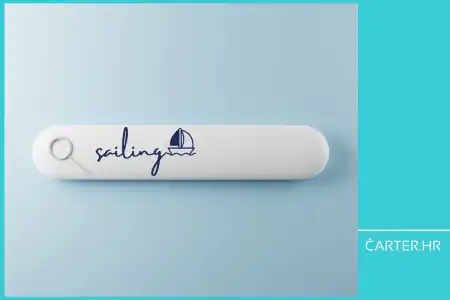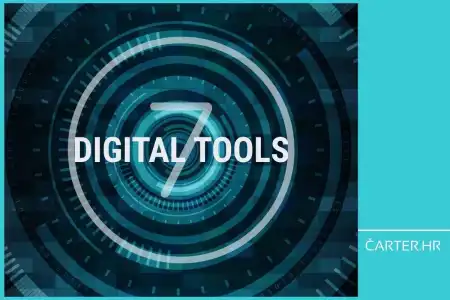
- 23.06.2025.
- News, Management
How to grow without expanding the fleet? In the charter industry, growth is often assumed to mean - more boats. But that’s neither the only nor the smartest way. Scaling means something else: how to get more out of existing resources - boats, people, systems. This includes better price management, more efficient organization, adding services that are valuable to guests while generating revenue for the company, and using tools that make daily work easier. The company doesn’t get bigger on paper, but it operates better and smarter.
On the Croatian coast, the number of charter vessels has drastically increased in recent years. The market has grown, but it’s also saturated. Many yacht charter companies have invested in fleet expansion, believing it to be the only way to grow. However, the market is now in a phase where having more boats no longer guarantees growth.
Due to seasonality and intense competition, it’s becoming harder to fill the calendar without offering serious discounts. Guests are more informed, their expectations are higher, and profit margins are thinner.
In this context, it becomes clear that increasing the number of vessels is often the most expensive and riskiest way to scale. Fortunately, there is an alternative.
But why scale without new vessels?
Most yacht charter companies in Croatia work with an existing fleet that has already been amortized. By focusing on better utilization of these boats, it’s possible to:
- Increase margins without raising costs
- Reduce dependence on the high season
- Operate more sustainably, with lower risks in case of a weaker season
- Reduce pressure on operations and staff
Companies that rely more on optimizing existing resources are more resilient and flexible in the long run.

1. Technology supports smarter business operations
In the yacht charter industry, what matters isn’t the number of vessels, but how well you manage your time and operations.
Technologies that were once reserved for large systems are now available to everyone, and without major investments.
The right technology doesn’t just save time, it also reduces errors, speeds up sales, and enhances your professional image.
It’s important to know which tools to use and where to apply them, and here are a few specific examples:
Booking systems
They allow direct bookings through your own website, as well as connections with agents and platforms. Proper setup means control over availability and pricing, without manual entry or duplicated data.
Yield management tools
These act as a “smart calculator” that automatically adjusts rental prices based on demand, the number of days until check-in, or occupancy levels during a certain period. This means the boat never goes too cheap when there’s demand, nor stays empty because the price was too high at the wrong time.
CRM systems
They enable guest tracking across seasons, recording of preferences, automation (e.g. sending birthday greetings), special offers for loyal guests, and personalized communication. A well-set CRM is more than a contact database - it becomes a tool for repeat sales.
Communication automation
Replying to inquiries, sending invoices, payment reminders, check-in information, and contracts - all of this can be automated. It reduces errors and creates the impression of a professional, well-organized company.
Smart companies don’t wait for technology to “come” to them - they choose tools that make the season easier, reduce pressure on the team, and improve the guest experience.
Scaling without increasing the number of vessels starts right here - with the way you run your daily business.
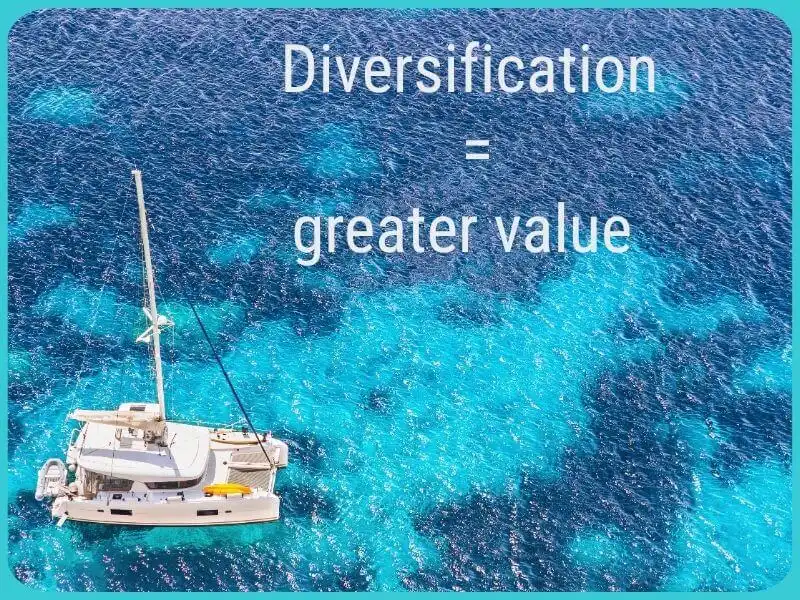
2. Diversifying the offer without physical expansion
Selling one or two more weeks is no longer enough. Guests don’t just want accommodation - they want content.
A guest’s time on board needs to be made more interesting, more memorable.
So, you don’t need to expand the number of vessels, but the depth of your service. That creates greater value for the guest, better differentiation on the market, and higher income per rental.
Here’s what that kind of diversification looks like in practice:
Themed tours
Offer personalized itineraries; tasting tours and local wineries, family-friendly routes with less sailing and more beaches, or cultural itineraries that link local festivals and historical landmarks.
Additional services
Give guests options that go beyond just the boat rental; private transfers from the airport to the marina, local guides who offer unique experiences that guests wouldn’t find on their own, sailing courses and skipper schools for families or groups looking for more than passive cruising.
Premium packages
For guests seeking a higher standard, offer pre-arranged packages that include catering, a pre-stocked pantry, concierge support, and a personalized itinerary. These packages raise the rental price without requiring significant extra effort.
Upsell products and equipment
The offer extends to things guests want to use during the trip: SUP boards, electric scooters, diving gear, drones for filming their journey, projectors for evening movies under the stars. All of this can be charged as an extra service and often pays off multiple times over during the season.
Diversification doesn’t require new investment in the fleet - it requires better understanding of guest needs. Whoever first manages to match guest expectations with local resources not only earns more, but also builds loyalty through an experience that can’t be found “in the catalog”. Scaling here doesn’t mean “more boats” - it means “more per boat”.
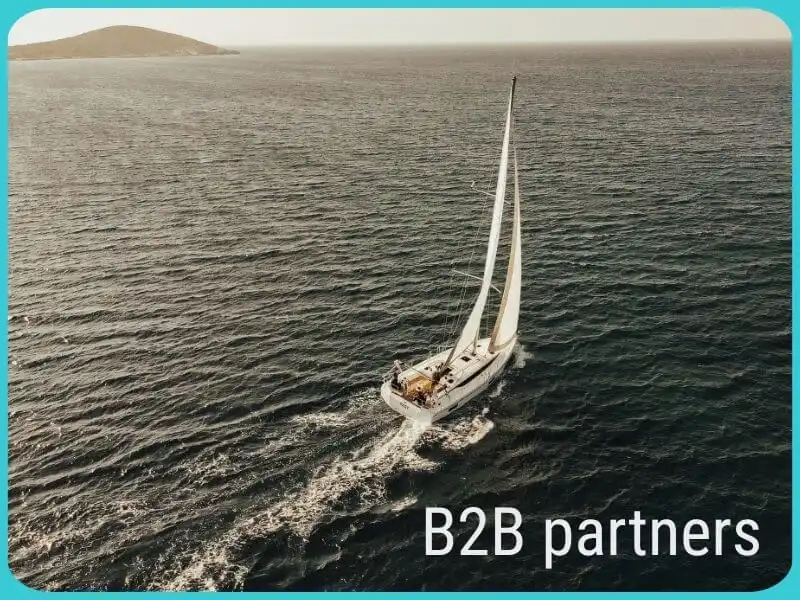
3. Stronger collaboration with B2B partners
In the yacht charter industry, a quality B2B partner is worth more than an additional boat. An agent or specialized agency can sell your boat faster and at a higher price - provided you give them all the necessary tools to do so.
Many yacht charter companies still expect agents to “guess” how and to whom to sell the boat, without ever giving them complete information or updated materials. That approach no longer works.
Good collaboration requires clear tools and mutual trust. These are the basics every yacht charter company should prepare for its B2B partners:
Professional photo and video materials
Without quality visuals, there is no sale - especially if you’re working with agencies targeting higher price segments. The materials must show the boat, but also the atmosphere, details, and potential experiences - everything that sells emotion, not just space.
Up-to-date availability data
Agents waste time if they have to send three emails just to find out if a boat is available. Integration with booking systems or regularly updated data is the bare minimum if you want serious cooperation.
A simple and transparent system for checking prices and dates
Clear pricing, discounts, surcharges, terms - all of this must be accessible to the agent in one click. If they’re not sure whether the price they’re quoting to the client is accurate, they won’t sell your boat.
In addition to technical prerequisites, choosing the right partner matters. Working with agencies that target specific niches may bring fewer inquiries, but significantly higher value per booking. Companies that invest in maintaining these relationships, regular communication, and partner support, build a long-term sales network that doesn’t rely on a single platform or market.
Collaboration with B2B partners is a strategy for scaling without additional operational costs. Those who realize this in time get more business without expanding their base.
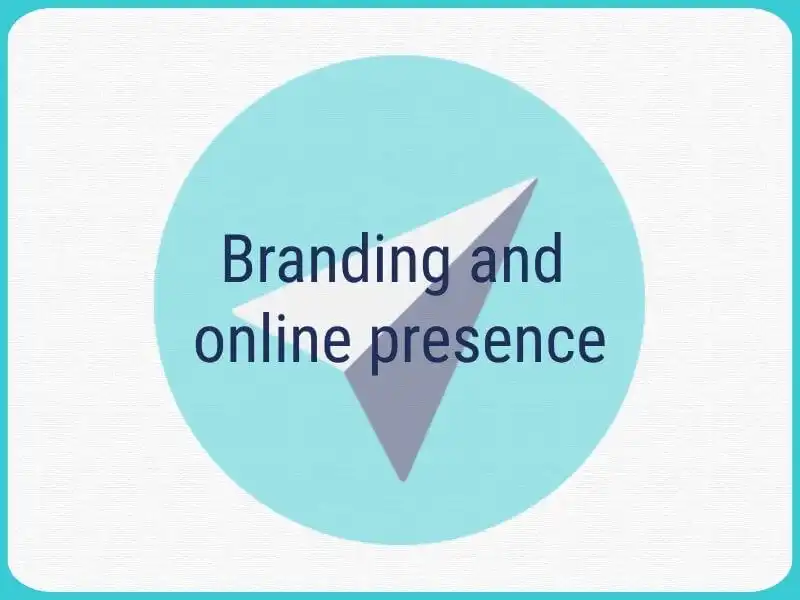
4. Branding and online presence as tools for added value
In a market where everyone offers the “same” boat, the difference is not made in meters of length or equipment, but in perception.
Guests don’t choose based solely on technical specifications - they choose based on the impression the company leaves. If you look professional, accessible, and reliable, you will receive more inquiries. If you don’t communicate that, not even the best boat will help.
Branding and online presence are tools with which you justify a higher price, increase direct bookings, and reduce dependence on intermediaries. Here’s what that means in practice:
Website
It must be clear, fast, and responsive. It doesn’t need hundreds of subpages, but it must allow the guest to see within seconds who you are, what you offer, and how to contact you. Translated at least into English, with clearly displayed fleet, prices, and a contact form.
Social media
Trust and emotion are built through Instagram, Facebook, and YouTube. Posts shouldn’t just show boats, but people, experiences, and moments - everything guests care about: what breakfast on deck looks like, what the skipper recommends, where the boat actually stops.
Reviews and reputation
Reviews are the modern form of word-of-mouth. Actively collecting feedback on Google and your responses that show you care demonstrate that you’re a trustworthy company.
Consistency in communication
Tone, visual style, and the messages you send must be aligned. If your website presents you as a premium service, but your Instagram features poor photos from the base with English mistakes, you’re damaging your own reputation and value.
A brand is not a logo and colors. A brand is the feeling you leave behind.
In the yacht charter industry, where the guest doesn’t see you in person before arrival, that first impression is often the only chance to be chosen.

5. Operational efficiency and better season preparation
Scaling doesn’t always have to come from outside, through marketing, sales, or new services. Sometimes the biggest shift is possible from within, through better management of daily operations.
Companies that seriously approach base organization, season preparation, and cost optimization often achieve greater growth than those investing in new boats while “patching things up” internally.
Here are specific areas where scaling is possible without expanding:
Base organization
A good schedule for service teams, predefined check-in and check-out processes, and clearly divided responsibilities between the base, sales, and booking - all of this saves work hours, reduces stress, and increases the ability to handle more bookings without increasing staff numbers.
Early booking and extended season
Working with guests and agents already in November and December for the upcoming season allows better planning and relieves last-minute panic. At the same time, companies that actively offer charters in April and October often secure a few more weeks of additional revenue, without the crowds and issues typical of July and August.
Cost optimization
Scaling isn’t just about growth - it’s also about saving. Group purchasing of consumables (detergents, linens, equipment), centralized service solutions, outsourcing administrative tasks (accounting, customer support) - all of this reduces fixed costs per boat. Lower cost per unit means higher profit at the same rental price.
Operational efficiency isn’t visible on social media, but it’s strongly felt at the end of the season - in the revenue table and in whether your team has the strength for another year.
Yacht charter companies that invest in “internal” scaling build healthier operations, rely less on external factors, and are better prepared for unpredictable situations, such as bad weather, a drop in demand, or changes in regulations or laws.
Growth without stress - but with a plan
Scaling doesn’t mean you need another boat, another loan, another base.
In most cases, better business results come from greater control over what you already have. Yacht charter companies that want to grow without additional burden can achieve this if they clearly set goals and apply tools that already exist on the market.
As a reminder, scaling in the yacht charter business happens through:
- Technology - which automates daily tasks, speeds up bookings, and helps with better pricing strategy.
- Offer - which expands with themed tours, additional services, and extras that increase the value of each yachtcharter.
- Relationships - through B2B partners who know how and to whom to sell your products when given the right tools.
- Image - through online presence that builds trust and justifies a higher price, even if you offer the same boat as the competition.
- Internal organization - which increases capacity and stability without expanding operations.
If you feel like you’re already doing everything you can, but the results aren’t growing as they should, the issue may not be effort - but approach. Scaling requires analysis, planning, and the courage to do something differently, even when the boats, guests, and market seem familiar.
On the platform čarter.hr, we regularly publish examples, tools, and ideas that come from real work with yacht charter companies.
If you’re looking for new ways to improve your business, sign up for our newsletter or contact us directly for a conversation.
Sometimes just one concrete suggestion is enough to steer the whole season in the right direction.
Categories of trends
- News
- Sale
- Marketing
- SEO
- Web design
- Social media
- Technology
- Regulations
- Management
- Education
- Finances
- User experience
Newsletter
Sign up for the newsletter and receive the latest trends and tips straight to your inbox



